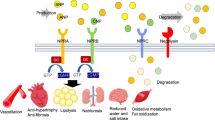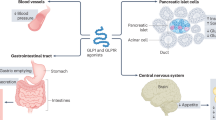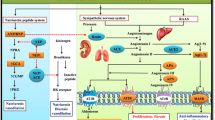Abstract
Antihypertensive drugs that inhibit the renin–angiotensin system (RAS) have been proposed to have additional benefits beyond their classic effects on the cardiovascular system, including reducing the risk of new-onset diabetes. Whether RAS inhibitors vary in ability to protect against new-onset diabetes is, however, unknown. The angiotensin II type 1 receptor (AT1) blocker telmisartan has been discovered to also activate the peroxisome proliferator-activated receptor-γ (PPARγ), an established antidiabetic drug target. In patients with hypertension and biochemical features of the metabolic syndrome, telmisartan has had beneficial effects on lipid and glucose metabolism. As a selective modulator of PPARγ, telmisartan does not cause the side effects of fluid retention and weight gain associated with conventional thiazolidinedione ligands of PPARγ. These observations raise the possibility that combined AT1 receptor blockade and selective PPARγ modulation with molecules such as telmisartan could provide greater protection from new-onset diabetes and cardiovascular disease than drugs that target either the RAS or PPARγ alone. The cardioprotective and antidiabetic effects of telmisartan are being assessed in two large clinical trials, the ONgoing Telmisartan Alone in combination with Ramipril Global Endpoint Trial (ONTARGET) and the Telmisartan Randomised AssessmeNt Study in ACE-I iNtolerant subjects with cardiovascular Disease (TRANSCEND).
Key Points
-
Patients with hypertension and the metabolic syndrome are at greatly increased risk of developing new-onset diabetes, and for this reason blood-pressure-lowering drugs with antidiabetic properties could be of considerable clinical value
-
Antihypertensive drugs that inhibit the renin–angiotensin system might have some beneficial effects on glucose metabolism, but the antidiabetic properties of these drugs are modest compared with those of drugs that activate the peroxisome proliferator-activated receptor-γ
-
The commonly used antihypertensive agent telmisartan can activate peroxisome proliferator-activated receptor-γ as well as block the angiotensin II type 1 receptor and could, therefore, provide greater metabolic and cardiovascular protection than drugs that inhibit the renin–angiotensin system alone
-
Ongoing clinical trials are being done to compare the effects of telmisartan, the angiotensin-converting-enzyme inhibitor ramipril, and combined telmisartan and ramipril on the rates of cardiovascular events and new-onset diabetes in high-risk populations
This is a preview of subscription content, access via your institution
Access options
Subscribe to this journal
Receive 12 print issues and online access
$209.00 per year
only $17.42 per issue
Buy this article
- Purchase on Springer Link
- Instant access to full article PDF
Prices may be subject to local taxes which are calculated during checkout




Similar content being viewed by others
References
Kurtz TW and Pravenec M (2004) Antidiabetic mechanisms of angiotensin-converting enzyme inhibitors and angiotensin II receptor antagonists: beyond the renin-angiotensin system. J Hypertens 22: 2253–2261
Dormandy JA et al. (2005) Secondary prevention of macrovascular events in patients with type 2 diabetes in the PROactive Study (PROspective pioglitAzone Clinical Trial In macroVascular Events): a randomised controlled trial. Lancet 366: 1279–1289
DREAM (Diabetes REduction Assessment with ramipril and rosiglitazone Medication) Trial Investigators (2006) Effect of rosiglitazone on the frequency of diabetes in patients with impaired glucose tolerance or impaired fasting glucose: a randomised controlled trial. Lancet 368: 1096–1105
Jandeleit-Dahm KA et al. (2005) Why blockade of the renin-angiotensin system reduces the incidence of new-onset diabetes. J Hypertens 23: 463–473
Scheen AJ (2004) Renin-angiotensin system inhibition prevents type 2 diabetes mellitus. Part 1. A meta-analysis of randomised clinical trials. Diabetes Metab 30: 487–496
Yusuf S et al. (2001) Ramipril and the development of diabetes. JAMA 286: 1882–1885
ALLHAT Officers and Coordinators for the ALLHAT Collaborative Research Group (2002) Major outcomes in high-risk hypertensive patients randomized to angiotensin-converting enzyme inhibitor or calcium channel blocker vs diuretic: The Antihypertensive and Lipid-Lowering Treatment to Prevent Heart Attack Trial (ALLHAT). JAMA 288: 2981–2997
Dahlöf B et al. (2002) Cardiovascular morbidity and mortality in the Losartan Intervention For Endpoint reduction in hypertension study (LIFE): a randomised trial against atenolol. Lancet 359: 995–1003
Pfeffer MA et al. (2003) Effects of candesartan on mortality and morbidity in patients with chronic heart failure: the CHARM-Overall programme. Lancet 362: 759–766
Lithell H et al. (2003) The Study on Cognition and Prognosis in the Elderly (SCOPE): principal results of a randomized double-blind intervention trial. J Hypertens 21: 875–886
Julius S et al. (2004) Outcomes in hypertensive patients at high cardiovascular risk treated with regimens based on valsartan or amlodipine: the VALUE randomised trial. Lancet 363: 2022–2031
DREAM Trial Investigators (2006) Effect of ramipril on the incidence of diabetes. N Engl J Med 355: 1551–1562
Pershadsingh HA (2004) Peroxisome proliferator-activated receptor-gamma: therapeutic target for diseases beyond diabetes: quo vadis? Expert Opin Investig Drugs 13: 215–228
Berger J and Moller DE (2002) The mechanisms of action of PPARs. Annu Rev Med 53: 409–435
Pershadsingh HA and Kurtz TW (2004) Insulin-sensitizing effects of telmisartan: implications for treating insulin-resistant hypertension and cardiovascular disease. Diabetes Care 27: 1015
Savage DB et al. (2003) Human metabolic syndrome resulting from dominant-negative mutations in the nuclear receptor peroxisome proliferator-activated receptor-gamma. Diabetes 52: 910–917
Benson SC et al. (2004) Identification of telmisartan as a unique angiotensin II receptor antagonist with selective PPARγ-modulating activity. Hypertension 43: 993–1002
Schupp M et al. (2004) Angiotensin type 1 receptor blockers induce peroxisome proliferator-activated receptor-γ activity. Circulation 109: 2054–2057
Yki-Jarvinen H (2004) Thiazolidinediones. N Engl J Med 351: 1106–1118
Picard F and Auwerx J (2002) PPAR(gamma) and glucose homeostasis. Annu Rev Nutr 22: 167–197
Tamori Y et al. (2002) Role of peroxisome proliferator-activated receptor-gamma in maintenance of the characteristics of mature 3T3-L1 adipocytes. Diabetes 51: 2045–2055
Nesto RW et al. (2004) Thiazolidinedione use, fluid retention, and congestive heart failure: a consensus statement from the American Heart Association and American Diabetes Association. Diabetes Care 27: 256–263
Delea TE et al. (2003) Use of thiazolidinediones and risk of heart failure in people with type 2 diabetes: a retrospective cohort study. Diabetes Care 26: 2983–2989
Mudaliar S et al. (2003) Thiazolidinediones, peripheral edema, and type 2 diabetes: incidence, pathophysiology, and clinical implications. Endocr Pract 9: 406–416
Janke J et al. (2006) Angiotensin type 1 receptor antagonists induce human in-vitro adipogenesis through peroxisome proliferator-activated receptor-gamma activation. J Hypertens 24: 1809–1816
Stangier J et al. (2000) Pharmacokinetics of orally and intravenously administered telmisartan in healthy young and elderly volunteers and in hypertensive patients. J Int Med Res 28: 149–167
Erbe DV et al. (2006) Molecular activation of PPARgamma by angiotensin II type 1-receptor antagonists. Vascul Pharmacol 45: 154–162
Ries UJ et al. (1993) 6-Substituted benzimidazoles as new nonpeptide angiotensin II receptor antagonists: synthesis, biological activity, and structure-activity relationships. J Med Chem 36: 4040–4051
Marshall TG et al. (2006) Common angiotensin receptor blockers may directly modulate the immune system via VDR, PPAR and CCR2b. Theor Biol Med Model 3: 1
Wienen W et al. (2000) A review on telmisartan: a novel, long-acting angiotensin II-receptor antagonist. Cardiovasc Drug Rev 18: 127–156
Schupp M et al. (2005) Molecular characterization of new selective peroxisome proliferator-activated receptor gamma modulators with angiotensin receptor blocking activity. Diabetes 54: 3442–3452
Berger JP et al. (2003) Distinct properties and advantages of a novel peroxisome proliferator-activated protein γ selective modulator. Mol Endocrinol 17: 662–676
Michel MC et al. (2004) Safety of telmisartan in patients with arterial hypertension: an open-label observational study. Drug Saf 27: 335–344
Zanchi A et al. (2004) Effects of the peroxisomal proliferator-activated receptor-gamma agonist pioglitazone on renal and hormonal responses to salt in healthy men. J Clin Endocrinol Metab 89: 1140–1145
Alberti KG et al. (2005) The metabolic syndrome—a new worldwide definition. Lancet 366: 1059–1062
Isomaa B et al. (2001) Cardiovascular morbidity and mortality associated with the metabolic syndrome. Diabetes Care 24: 683–689
Lakka HM et al. (2002) The metabolic syndrome and total and cardiovascular disease mortality in middle-aged men. JAMA 288: 2709–2716
Balkau B et al. (2003) The incidence and persistence of the NCEP (National Cholesterol Education Program) metabolic syndrome. The French D.E.S.I.R. study. Diabetes Metab 29: 526–532
Sattar N et al. (2003) Metabolic syndrome with and without C-reactive protein as a predictor of coronary heart disease and diabetes in the West of Scotland Coronary Prevention Study. Circulation 108: 414–419
Shulman AI and Mangelsdorf DJ (2005) Retinoid × receptor heterodimers in the metabolic syndrome. N Engl J Med 353: 604–615
Vitale C et al. (2005) Metabolic effect of telmisartan and losartan in hypertensive patients with metabolic syndrome. Cardiovasc Diabetol 4: 6
Honjo S et al. (2005) Possible beneficial effect of telmisartan on glycemic control in diabetic subjects. Diabetes Care 28: 498
Derosa G et al. (2004) Comparison of the effects of telmisartan and nifedipine gastrointestinal therapeutic system on blood pressure control, glucose metabolism, and the lipid profile in patients with type 2 diabetes mellitus and mild hypertension: a 12-month, randomized, double-blind study. Clin Ther 26: 1228–1236
Fogari R et al. (2004) Effect of telmisartan, losartan and lisinopril on insulin sensitivity in hypertensive patients with and without insulin resistance. Eur Heart J 25: 78–78
Koulouris S et al. (2005) Comparison of the effects of ramipril versus telmisartan in reducing serum levels of high-sensitivity C-reactive protein and oxidized low-density lipoprotein cholesterol in patients with type 2 diabetes mellitus. Am J Cardiol 95: 1386–1388.
Gonzalez-Albarran O et al. (2006) Effect of telmisartan on insulin sensitivity in patients with type 2 diabetes and metabolic syndrome. J Hypertens 24 (Suppl 4): S126
Shimabukuro M et al. (2007) Effects of telmisartan on fat distribution in subjects with the metabolic syndrome. J Hypertens, in press
Chan JM et al. (1994) Obesity, fat distribution, and weight gain as risk factors for clinical diabetes in men. Diabetes Care 17: 961–969
Teo K et al. (2004) Rationale, design, and baseline characteristics of 2 large, simple, randomized trials evaluating telmisartan, ramipril, and their combination in high-risk patients: the Ongoing Telmisartan Alone and in Combination with Ramipril Global Endpoint Trial/Telmisartan Randomized Assessment Study in ACE Intolerant Subjects with Cardiovascular Disease (ONTARGET/TRANSCEND) trials. Am Heart J 148: 52–61
Acknowledgements
PAREXEL MMS provided writing assistance, comprising preparation of a draft from slides and audio transcript, preparation of figures and obtaining copyright permissions, proofreading, and reference checking.
Author information
Authors and Affiliations
Ethics declarations
Competing interests
TW Kurtz has received lecture honoraria from Boehringer Ingelheim, GlaxoSmithKline, Pfizer and Merck. He has also declared associations with companies that sell or have financial interests in angiotensin II receptor antagonists and ligands for proliferator-activated receptor-γ.
Rights and permissions
About this article
Cite this article
Kurtz, T. Beyond the classic angiotensin-receptor-blocker profile. Nat Rev Cardiol 5 (Suppl 1), S19–S26 (2008). https://doi.org/10.1038/ncpcardio0805
Received:
Accepted:
Issue Date:
DOI: https://doi.org/10.1038/ncpcardio0805
This article is cited by
-
Telmisartan ameliorates insulin sensitivity by activating the AMPK/SIRT1 pathway in skeletal muscle of obese db/db mice
Cardiovascular Diabetology (2012)
-
Telmisartan protects against insulin resistance by attenuating inflammatory response in rats
Journal of Huazhong University of Science and Technology [Medical Sciences] (2011)
-
Adipose Tissue–Specific Regulation of Angiotensinogen in Obese Humans and Mice: Impact of Nutritional Status and Adipocyte Hypertrophy
American Journal of Hypertension (2010)
-
Novel therapeutic targets for hypertension
Nature Reviews Cardiology (2010)



